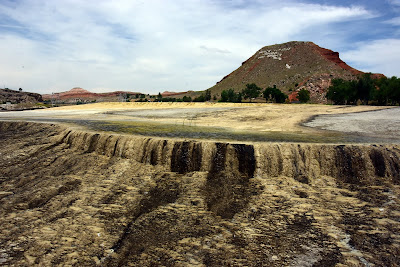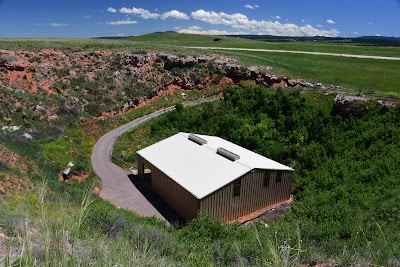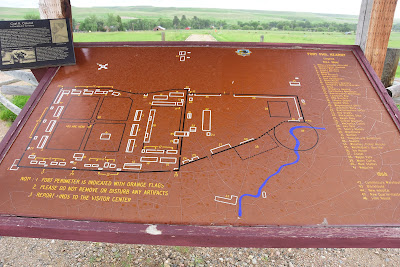I wasn't quite certain exactly what direction we needed to go this morning, even to get out of Riverton, so we made our first stop right away. Part of the reason is that I had forgotten to glance at the map this morning and memorize the route, and part was because we'd seen one of the brown historic interest signs as we left the RV camp telling us that just a mile or so off Riverton's main street was the "1838 mountain man rendezvous site.
Now, I didn't hold out much hope that there would be anything of interest at the rendezvous site other than a graffiti-covered marker, but I thought, what the heck, I have to stop anyway to review our intended destination for the day. So we pulled into the side road and started into the heart of what turned out to be Riverton's wrecking yard heaven, where wrecked cars outnumbered people. Still, we spent the time as we cruised by the hundreds of man's monuments to industrial excess discussing the possibility that someone there might have a windshield for our 1983 Toyota Cressida.
Unfortunately, after we drove the required distance mentioned by the historic interest sign on main street, we found another sign that told us to "Turn right" for the 1838 Rendezvous Site." When we'd gone another couple of blocks and discovered yet another turn, this time a left, we had all but decided to rethink our off-road experience, especially since the road had turned to rutted dirt and gravel at the aforementioned right jog.At that point, since we didn't have the patience to keep discovering new "legs" of the rendezvous site road, we pulled the rig into a field which had a large enough place to turn around, then parked. I told Concetta we'd just look at the map where we were, then retrace our tracks back to the highway and resume our exit from town.
But Concetta said I really ought to at least get out and photograph the street sign nearest us which sported the alluring name of "Fur Trapper Lane," I told her okay, I'd do it, but then we'd head back. When I got out of the rig to shoot the street sign, I happened to walk a bit to the east and there, right below us, was the open field that was meant to be thought of as the site of the 1838 Rendezvous.
When I had shot the street sign, I got back in the rig and told Concetta that we were going to forge ahead as our quarry was but a hundred yards away. Once there, I got out and strolled around the clearing, shooting photos in all directions, so that I might eventually do the necessary research and perhaps discover where I had miraculously photographed the correct spots.Though I'm not an expert on the mountain-man rendezvous that took place all those years ago in 1838, I found on the web a discussion of the annual re-enactment that takes place where I was standing. Read on:
"The fun starts with a parade down Main Street in Riverton, followed by opening ceremonies and Native American dancing. Then the 1838 Mountain Man Rendezvous begins with black powder shooting, hawk ‘n knife competitions and numerous seminars centered around the fur trapping era. And ‘Traders Row’ is a great place to bargain for a souvenir."
"The organizers of the 1838 Mountain Man Rendezvous pride themselves on having a “beginners” or “teaching” rendezvous with seminars offered. Family day activities for kids and “nonparticipants" in the rendezvous. There are seminars on fire starting with flint and steel, dutch oven cooking, flint knapping, Teepee set-up and organization, various trapping methods, historical information about the era, and many others.""The 1838 Mountain Man Rendezvous is open to the public and family friendly. For those “beginner” rendezvousers, who are looking to join a richly rewarding and fun event you will not disappointed! Also, pets are welcome but must be kept on a leash."
Of course, I hadn't yet researched the foregoing, so once I had exhausted the potential shooting angles, and Concetta and I had dragged out the map and decided on our route, we reversed our tour out past the tons of moldering iron, rubber, and glass and regained Riverton's main street. From there it was an easy task to grab Route 789 south and began our sojourn for the day.
Which we did...for all of 15 miles or so, until we entered the town of Hudson and discovered it was Carnival Day and they were having a car show right on main street. Well, not wanting to slight the good people of Hudson, I pulled right over and announced that we just HAD to go photograph the cars.Concetta presented no counter argument, so we parked in a convenient lot across the street from the festivities, then quickly set out to "stretch our legs."
Save for a couple of seemingly stock Model A Fords, virtually all of the assembled vehicles had been modified or "improved" in some way. Still, it was a beautiful blue-sky day, the cars were sporting a variety of festive colors, and I knew that the camera was just itching to photograph something.
So for the next thirty minutes or more we wandered hither and yon, shooting anything and everything that gleamed under the summer sun, and a couple of times we actually met and introduced ourselves to car owners. The first person we met was Steve Warner who had a lovely purple 1972 Plymouth Duster that he had acquired in Kansas City and had the previous owner ship to him. Steve turned out to be just a great guy to talk with, and I ended up recounting my entire history with my first car, a 1959 Plymouth station wagon that had more than one opportunity to kill me, but thankfully failed.
The second guy, Jake Griffin, was just as easy to talk to, and we spent a few minutes with him. Jake had brought his grandmother's 1951 Plymouth, which was in original condition, and I think Jake intended to keep it that way. I say that because ordinarily Jake produces hot show cars for other folks and was proud to point out that he had "done" the black Camaro that another car-show enthusiast was displaying just a few spaces away. But Jake's granny had sold him the '51 because, she said, he was the only grandchild with any sense.Finally, and with reluctance, Concetta and I retraced our steps to the RV to resume our journey south. We stopped on the way at the local bakery, just across the street from the car show, to inquire about homemade cookies and bread, but they were already sold out, most likely to the car-show guys and other participants. It was time to get moving as it was mid morning and we hadn't gone twenty miles yet.
Our next stop was the town of Lander, named just as the county in our home state of Nevada, for Frederick Lander, an explorer around the west in the 1840s. In Lander we thought we knew where we were going, but we were wrong. So, since we were lost anyway, we stopped to do a bit of grocery shopping. Once that was accomplished, I accosted the first person we met in the parking lot and asked for directions. The guy knew exactly what we needed to do, and immediately pointed us in the direction from whence we had just come.
Okay, so reaffirming that asking questions is almost always the best thing to do when you're lost, we happily turned the RV back in the direction of the Lander downtown, through which we had just cruised, and set off again. But not for long. Since we had found the cupboard to be bare in the Hudson bakery, I was on the lookout for another bakery as we rolled through Lander. Then, when I saw a sign for a coffee house and bakery on main street, I immediately stopped in a miraculously available parking spot and dashed back to try my hand at homemade cookie gathering.Once inside the shop I scanned the lighted cases for anything resembling cookies but didn't see any. I wondered if the very quiet and shy young student standing near me at the order counter might know if the bakery did cookies, so I just asked her. Having put shyness in my past decades ago, I find nowadays that it's just best to ask a stranger what you want to know rather than wander around fruitlessly in the dark.
Well, it was obvious that the young student was still in her shy stage of life because I could tell her blood pressure went up by at least 20% and she couldn't bring herself to look in my direction. Finally, she managed to croak out that she didn't know. It took her so long to answer that I had by then noticed a stack of cookies right next to the register, which I helpfully pointed out to my young confidant just in case she should ever need to know. She only managed a nod at that point.
When I got to the register I ordered a dozen cookies and the two clerks looked at each other like I'd just asked them to bake me a cake while I waited. "Ah," the first clerk said, I don't think we have that many." He looked toward the female clerk, but she just shrugged.I pointed to the cookies on the counter and said, "These all you got?"
The male clerk nodded and agreed that they were.
"Can I have all of them?" I asked.
Both clerks agreed that I could, and said they'd discount the per-cookie price since I was buying all of them.
And that was the sum total of my cookie adventure. After paying for my new lunchtime snack, I dashed back to the rig, and soon we were off in the correct direction toward the famous South Pass and further adventures.
South Pass is famous among people like myself who study the westward migration of the 19th century. Before South Pass was discovered and fully utilized, wagon trains were most often involved in some perilous journeys over the Sierra mountains on their way to the California gold fields, or to the Oregon Territory. Steep and rocky ascents, repeated fordings of raging mountain streams, and the disassembly of wagons so they could be winched up the faces of cliffs were commonplace in the emigrant's quest for the Pacific Coast. But with South Pass the ascent was so gradual and rock free that the emigrants hardly knew they were climbing.As Concetta and I cruised over South Pass in the opposite direction that the emigrants had made their laboriously slow way up the gradual grade, we enjoyed some of the most open and lovely scenery that we have yet experienced. We stopped often to take photos, read the various historic markers, and enjoyed the incredible cloud-filled vault of the blue sky as it enveloped the beautiful rolling landscape above the historic plains of Wyoming.
Once we reached Rock Springs and Interstate 80 it was time to get back to business, find a camp, and get settled in before the mass of humanity figured out that there wasn't 20 hours of daylight in a travel day. We always try to get settled by 3:00 p.m. if possible, which almost always ensures us a nice space somewhere. Today we arrived a bit late and didn't make the Rock Springs KOA until 4:00 p.m. There the line to check in was already growing, and we were third. But we succeeded in getting a nice spot with a view of coaches on each side, the camp laundry, and the rumbling Interstate to the south. But you know, sometimes you have to grab what you can and savor the times you found a mountain stream to camp beside.And when you go seeking the very best camp spot on the mountain, beside your favorite stream, or on a lovely beach somewhere, we wish you exciting destinations and memorable travels from the Davises, the Happy Wanderers.
























































